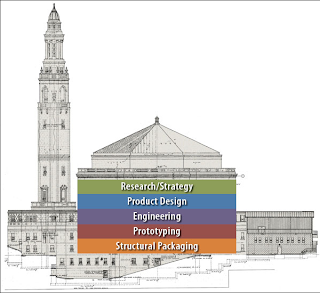Corporations face many challenges when trying to encourage entrepreneurship within their organizations. One of the biggest challenges for entrepreneurs acting within large corporations is securing the resources and support needed to get their idea off the ground. Large corporations tend to be extremely revenue driven, and senior management focuses on those projects that will be best for the company's bottom line. Often such projects are the "safe" ones that are "at scale". "The competitive advantage of the established global firms is in the operation of businesses with mature products, with substantial market penetration, credibility and relationships usually spanning multiple geographic regions."
In general the challenges that face corporate entrepreneurship can be broken down into three categories: strategy challenges, incentives and organizational challenges, and decision making challenges.
Strategy challenges can come from a lack of integrated decision making at the highest level. In large corporations entrepreneurship is viewed as small business that requires a great deal of up-front investment, and has very few customers at the start. Because of this, entrepreneurship opportunities are designated as low priority items, and therefore do not garner the amount of attention they may deserve. Some entrepreneurship opportunities could potentially take business away from the established core businesses of the corporation, and thus create a tricky balancing act between supporting the new idea or continuing to forge ahead with the established one that is generating a steady stream of revenue. Economic downturns also play a significant role in strategy. When the economy is going well corporations are more likely to support entrepreneurial activities. However, when the economy takes a turn for the worse, like it did just a few years ago, many corporations will immediately scale back on none-core activities of which, entrepreneurial endeavors are typically the first to get cut. Thus, entrepreneurial endeavors tend to be very cyclical, following the ups and downs of the economy. Another problem with corporate strategy is that large corporations have a tendency to view new opportunities in much the same way that they view established core businesses. If the new idea doesn't fit within the established product line it may be given very little consideration by upper management because it does not conform to what the corporation is currently doing. The main problem with this thought process is that it can leave corporations open to being blindsided by new entrants, who have game changing ideas, or by shifts in customer preferences.
At the same time, established corporations have a tendency to avoid risky endeavors. Many view failure as a career-ending event, which leads top management to focus the corporation's activities on surer-bets that have a high probability of success. Because of this entrepreneurial ventures will get kicked to the curb do to their high risk nature, and unknown ability to succeed. Another problem regards where to house the new business within the established organizational structure of the corporation. If the venture is located within an existing business unit it will have to mesh with current management that is in place, and might not be best suited for leading the new venture. If the new venture forms a separate unit then they will likely be cutting themselves off from resources necessary to get the project off the ground. Finally, if the new venture constitutes itself outside of the established organization all together there is a high likelihood that the objectives of the new venture will not jive with the ones of the established corporation.
In making decisions regarding new business ventures managers tend to not look far enough ahead when projecting financial outcomes of the new venture. Often, they will look more at a short term view of the new venture, which typically is not enough time for it to get established. When testing the waters for new ideas large corporations also have a tendency to use already established methods of market feedback analysis. Traditional focus groups, or surveys will not uncover those new ideas that have potential to be disruptive or breakthrough in nature. Large corporations are also known for their bureaucracy. Bureaucracy and innovation typically do not work hand-in-hand, and the incredible number of steps necessary to make a decision within a highly bureaucratic corporation can stifle creativity and innovation. Finally, performance measures and compensation in large corporations are tied directly to set targets and metrics, which tend to promote incremental change, but fall short stimulating interest in wholesale change. Measurement of breakthrough ideas becomes difficult using set metrics and targets.
Having discussed the many problems that entrepreneurship faces within large corporations with established businesses it's now time to turn our attention toward some potential solutions. Having now worked for two different large corporations I have seen how they operate, and have some suggestions on how they can change to better promote new ideas. When I began work at my first job, which was for an established global organization, and again at my second job, also for an established large corporation, I entered at a time when both were bringing in a significant amount of new, young talent. In each case, the new people are brought along to learn the corporation's standards for how things are done. Such standards are essential to any business, but in my opinion will not lead to innovation. In my mind corporations need to take better advantage of the new people they bring in who might be able to offer a fresh perspective on how to do things, which could lead to new and innovative opportunities. I am not discounting the importance of learning and mastering the standards of the organization as they are essential for keeping the core business running smoothly. I do think, however, that people need to be given more opportunities to be creative and challenge the established way of doing things. Whether this means setting up some set-time for brainstorming during the workweek, or maybe having a monthly offsite where people can bounce ideas off one another I am not sure. Steve Jobs had a yearly retreat in which he would select his top 100 employees and whisk them away to brainstorm ideas for the future of Apple. Jobs also recognized that in order for Apple to remain successful that he would need to maintain design as a core competency. Because of this, designers at Apple were considered to be the most important people in the organization and reported directly to Jobs. As was mentioned early when discussing the problems that corporations face when trying to promote entrepreneurship, compensation can play a significant role. Performance evaluations are based solely on one's ability to do work that meets established metrics, which funnel directly into the corporations core business roadmaps. Nowhere is an employee evaluated based on their ability to innovate. My current employer will offer an employee up to $1000 for a patented idea, which does provide some reward. The only problem is that there is little time to work on such ideas in between completing tasks to support core business work. At the same time, the risk of losing one's job because of a bad idea needs to be eliminated as it stifles the employee's desire to think outside the box for fear of being fired.





